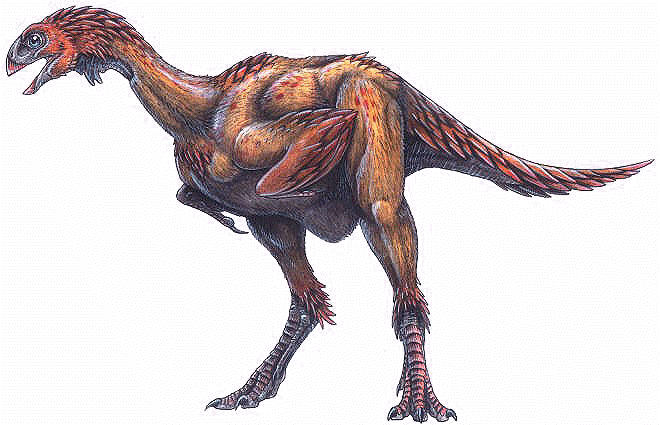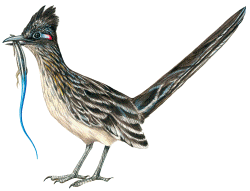|
Avimimus portentosus (Kurzanov, 1981) |
|
 |
|
Name Means: |
"Bird mimic" |
Length: |
5 feet (1.5 m) |
|
Pronounced: |
AYV-ee-MIME-us |
Weight: |
45 pounds (20 kilos) |
|
When it lived: |
Late Cretaceous - 95 MYA |
|
|
|
Where found: |
Mongolia, China |
|
|
|
|
Avimimus was discovered by Russian
paleontologist Sergei Mikhailovich Kurzanov during the exploration of
the Joint Soviet-Mongolian paleontological expedition in the summer of
1973, at the Udan-Sayr (southern Gobi) location in Mongolia. It was a
fairly complete skeleton of a bird-like theropod. With the exception
of a crushed skull fragment, the bones were very well preserved.
Udan-Sayr is in the foothills of the Gurvan-Sayhan mountain range.
The red colored sand he deposits are 15 meters thick and can be very
accurately dated. This is proven by the presence of teeth from
Tarbosaurus, a carnosaur, known from the deposits of that age
from various locations in the Southern Gobi. Three other partial
skeletons were later recovered. It was named by Kurzanov in
1981. |
Avimimus
looked so much like a bird that its name literally means that it
imitates a bird. It looks like a large reptilian roadrunner. Avimimus had a
long, lean neck topped by a short skull that was equipped with a
toothless beak and a relatively large braincase. It had long, slender
back legs built for fast running. But its front limbs had not yet
evolved into wings. They were lightly built and equipped
with sharp, curved claws. The bones in it's wrists were actually
fused together, much like that of the modern day cockatoo. In
fact, Avimimus had the ability to fold its whole arm against its
body, much like the wings of a bird. Unlike a bird however,
Avimimus had a long bony tail. What's more, its pelvis resembled
that of other theropods.
It was the first dinosaur to so clearly express bird features, in such
large numbers. It is also the first theropods with such
unusual structure of the pelvis. Such a combination of unique
features places Avimimus in a category all its own. |
 |
|
Roadrunner -
Geococcyx californianus |
|
|
|
It is possible that Avimimus
had feathers, however, deposits around its body are too coarse for
such features to be preserved. However it was unearthed near other
dinosaurs similar to itself, particularly Sinosauropteryx and
Caudipteryx and their feathers were preserved. Even though none
have so far been found, there is evidence that Avimimus could
have had feathers. There are small ridges on its forearm that could
be anchor points for feather shafts. Modern birds have bone "dimples"
at the point of feather attachment, however the ridges present in
Avimimus could be a pre-adaptation to feather attachment. Even if
Avimimus did have feathers, it would seem very unlikely that it would
be able to achieve flight, particularly due to its large body. |
|
One of the great enigmas to have surfaced in the last quarter century
of dinosaur paleo, Avimimus has features that could be
ascribed to
sauropods,
hadrosaurids, basal
theropods, oviraptorids, birds, and
ornithomimids. Sometimes considered a chimera, recent remains
indicate it was an Oviraptor. |
|
|
|
|
|
|
|
|
Edugraphics.Net | Feenixx Publishing |
|
|
|
|
![]()

